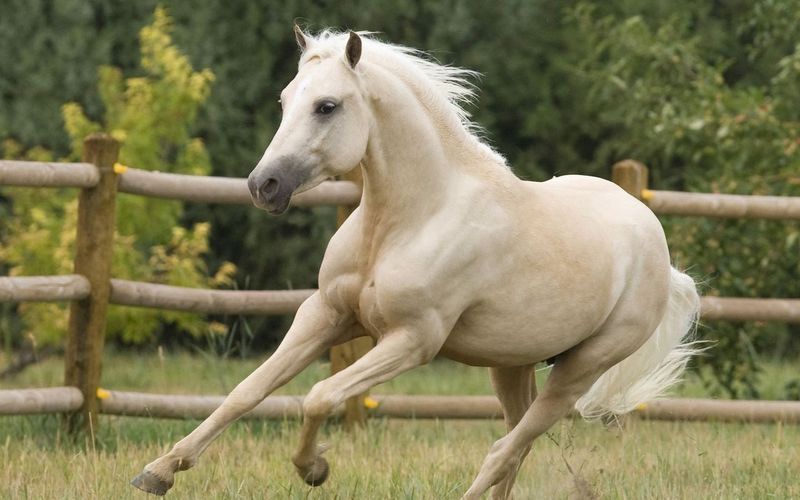Arabian and Thoroughbred horses are two of the most popular horse breeds, each with unique characteristics and histories.
They are often compared due to their roles in racing, endurance, and their distinct physical and temperamental traits.
Understanding the key differences between these breeds can help enthusiasts and potential owners make informed decisions.
1. Physical Appearance

Arabian horses are renowned for their distinctive physical features. They typically have a dished face, large nostrils, and a high-set tail. These attributes give them a unique and elegant appearance. In contrast, Thoroughbred horses are known for their longer legs and leaner bodies, designed for speed.
Their build is more aerodynamic, which is crucial for racing. The physical differences between these breeds are not just cosmetic; they reflect their historical roles and functionalities. Thoroughbreds, with their long legs, are optimized for flat racing.
Meanwhile, the compact build of Arabians supports endurance riding over long distances. Both breeds are visually striking in their own ways, with Arabian horses offering a more classic, almost mystical allure and Thoroughbreds exuding athleticism and power.
The skeletal structure also plays a role in distinguishing these breeds. Arabian horses have one fewer vertebrae in their backs and tails, contributing to their unique silhouette.
Thoroughbreds, meanwhile, have a straight profile without the distinctive head shape of the Arabian. These anatomical differences are significant for breeders and racers when selecting a horse for specific activities or events.
Ultimately, the choice between an Arabian and a Thoroughbred might come down to personal preference in physical aesthetics and the intended use of the horse.
Whether one prefers the high tail carriage and curved profile of the Arabian or the sleek, racing-ready form of the Thoroughbred, each horse type presents a unique beauty that captivates enthusiasts around the world.
2. Temperament

Temperament is a crucial factor for those who work closely with horses, and Arabian and Thoroughbred horses exhibit different personality traits.
Arabians are often described as spirited yet gentle. They are known for their intelligence and strong attachment to humans, making them excellent companions.
This deep bond can be advantageous for training and riding, especially in endurance events where cooperation and understanding between horse and rider are essential.
Thoroughbreds, in comparison, are often characterized by their high energy and competitive nature. They are bred for speed and agility, and this is reflected in their temperament.
They can be more headstrong and require experienced handling, especially in high-pressure racing environments. Their fiery nature can be both a challenge and an asset, depending on the context.
The temperament of each breed should align with the rider’s experience and intended activities. Arabian horses are generally suitable for riders who value a calm yet responsive partner for riding adventures.
In contrast, Thoroughbreds may appeal to those who are looking for a horse with a strong drive and competitive spirit. Understanding these differences helps in choosing the right horse for personal preferences and specific equestrian disciplines.
3. Historical Background

The Arabian horse is one of the oldest and most influential horse breeds in history, with origins dating back thousands of years in the Arabian Peninsula.
Known for their endurance and stamina, Arabians were bred by the Bedouins for their ability to travel long distances in harsh desert climates. Their history is rich with tales of loyalty and bravery, as they were essential companions for nomadic tribes.
Thoroughbred horses, on the other hand, have a more modern history, originating in 17th century England.
Bred specifically for racing, Thoroughbreds are the result of crossbreeding native English mares with imported Arabian, Turkoman, and Barb stallions. This blend created a horse breed with unparalleled speed and agility, suited for the burgeoning sport of horse racing.
The historical contexts of these breeds have influenced their development and use. While the Arabian maintains its role in endurance and companionship, the Thoroughbred has become synonymous with competitive racing.
These historical backgrounds not only provide insight into the breeds’ characteristics but also highlight their respective roles in human culture and sport over the centuries.
4. Training And Riding Style

Training techniques and riding styles differ significantly between Arabian and Thoroughbred horses due to their distinct temperaments and physical capabilities. Arabian horses are often trained for endurance and versatility.
Their intelligence and willingness to learn make them suitable for various equestrian disciplines beyond racing, such as dressage and trail riding. The training approach for Arabians often focuses on building trust and developing communication between rider and horse.
Thoroughbreds, bred primarily for the racetrack, are trained with a focus on speed and performance. Their training regimes are rigorous and highly specialized, aiming to enhance their natural racing abilities. This includes sprint training, agility drills, and maintaining peak physical fitness.
Riding a Thoroughbred often requires skill in managing their energy and drive, making it essential for riders to have experience in handling high-energy horses.
Understanding the training and riding styles preferred by each breed can aid riders in choosing the right horse for their interests.
While Arabians offer a well-rounded experience suitable for various activities, Thoroughbreds provide an exhilarating ride for those passionate about racing and speed. The choice will depend on the rider’s goals and the type of equestrian sport they wish to pursue.
5. Endurance And Speed

Arabian and Thoroughbred horses are celebrated for their prowess in endurance and speed, respectively. Arabian horses have long been favored for endurance riding competitions.
Their ability to sustain long distances at a steady pace without tiring is legendary. This endurance is rooted in their desert heritage, where stamina was crucial for survival and travel.
In contrast, Thoroughbreds are the quintessential racehorses, known for their incredible speed. Bred for sprinting, they dominate the world of horse racing with their explosive bursts of pace. This speed is a product of selective breeding aimed at refining their fast-twitch muscles, ideal for short, intense races.
The choice between an Arabian and a Thoroughbred often depends on the rider’s preference for endurance events or short-distance speed races.
While Arabians excel in long, grueling competitions, such as endurance racing, Thoroughbreds shine on the racetrack, where speed is the ultimate measure of success. Both breeds offer exciting opportunities for equestrians, depending on their sporting interests.
6. Health And Lifespan

Health and lifespan considerations are important when choosing between Arabian and Thoroughbred horses. Arabians are generally considered hardy horses with a long lifespan, often living well into their 30s.
Their robust health and resilience can be attributed to their historical development in harsh desert environments, where only the strongest survived.
Thoroughbreds, while known for their athletic prowess, tend to have a shorter lifespan compared to Arabians.
Their intense breeding for speed can sometimes lead to health issues, such as joint problems and injuries related to racing. This necessitates careful management and veterinary care to ensure their well-being.
When considering a horse’s health and lifespan, potential owners should weigh these factors. Arabians may be preferable for those seeking a long-term companion with fewer health issues, while Thoroughbreds can be a thrilling choice for those interested in competitive racing, albeit with a need for vigilant health monitoring.
Ensuring proper care and understanding the health needs of each breed will lead to a rewarding equestrian experience.
7. Popularity And Usage

Both Arabian and Thoroughbred horses enjoy immense popularity, but their uses differ significantly. Arabian horses are renowned for their versatility and are commonly used in endurance riding, show competitions, and as pleasure horses.
Their adaptability makes them a favorite among riders who engage in diverse equestrian activities.
Thoroughbreds hold a special place in the world of horse racing. Their primary use is in flat racing, where they have achieved legendary status.
Beyond racing, Thoroughbreds are also used in show jumping, dressage, and even as polo ponies. Their competitive nature makes them a preferred choice for equestrians focused on high-stakes sports.
The popularity of each breed is reflected in their widespread presence in different equestrian sports. Whether one is drawn to the grace and endurance of the Arabian or the speed and competitiveness of the Thoroughbred, both offer unique opportunities for horse enthusiasts.
Understanding their popular uses can guide prospective owners in selecting a breed that aligns with their interests and equestrian goals.
8. Breeding And Genetic Traits

Breeding practices and genetic traits distinguish Arabian and Thoroughbred horses in significant ways. Arabian horses are celebrated for their pure bloodlines, maintained over centuries, which contribute to their uniform appearance and temperament.
This purity is a source of pride for breeders and contributes to the Arabian’s consistent characteristics across the breed.
Thoroughbreds, developed through the crossing of different breeds, display more genetic diversity. This diversity has been instrumental in enhancing their speed and agility.
Breeding Thoroughbreds often focuses on performance traits, aiming to produce the fastest and most competitive racehorses.
The genetic traits of each breed reflect their historical purposes and current uses. Arabians are valued for their consistent, predictable traits, making them ideal for endurance and companionship.
Thoroughbreds, with their varied genetic backgrounds, offer exciting potential for racing excellence. Prospective breeders and owners should consider these genetic aspects when choosing a horse, ensuring alignment with their breeding and sporting aspirations.

